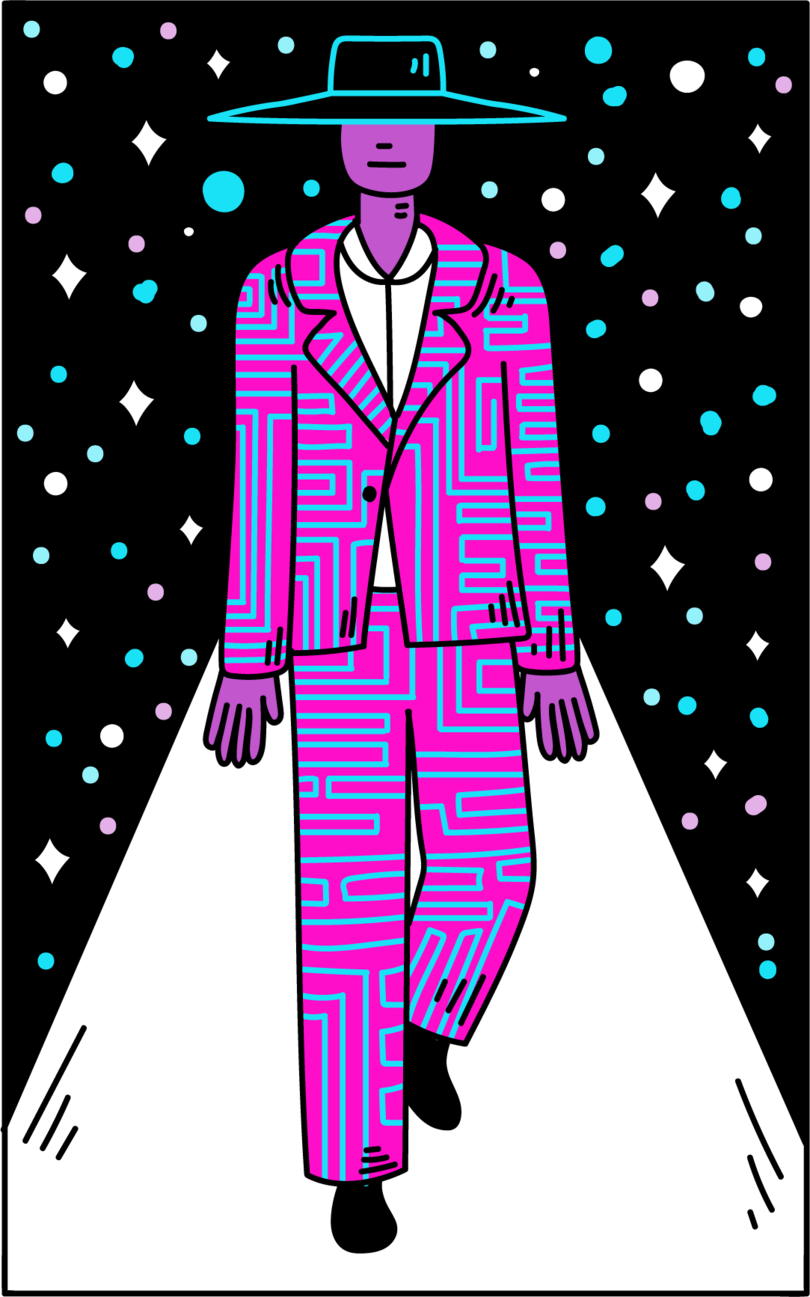The News
All the news, all the time.
3 January 2060
Press release

Paris Fashion Week 2060 special report
It’s been a devastating few decades for the fashion industry as it transitions away from the traditional “seasons” of S/S and F/W to favour a timeless Resort format more befitting the sunny new outlook of the 2060s. With the newly launched space mirrors climate-controlling our lives to the minutest degree, we are seeing more and more reflective inspirations from bias-cut rescue-blanket gowns and party attire to disco ball inspired legwarmers and McQueen-esque armadillo heels that pay homage to the mirrors dreamed up and launched from Shanghai’s labs last year.
In the collections? A kaleidoscopic medley, iridescent PU fabrics and an attention to the unseen spectrums of ultraviolet and infrared. It’s an odd mash-up in terms of garments, with light basic T-shirts and trousers trimmed with synthetic furs (microscopic metal fibres that read to the eye as a grey fur) – furkinis, for example. In other words, it’s glamour, a return to the skimp and flair of some 70 years ago. Iridium-infused polymers create trippy subtleties, and leave the texture of clothing distinctly metallic.
We never thought we’d see the sun set on overengineered doomer fashions of the thirties, the apocalypse we anticipated was actually a psychic fatigue of it. To some, though, the glamour we have now isn’t one of choice, so much as luxury’s assault – unceasing and perfectly acclimatized to our consumption before we ever know it. The more avant-garde designers are trying to break out quite literally from the civil enclaves of perpetual resort and pamper. Silhouettes mock the glamorous revivalism found today, with floor-length dresses designed to trail and soil at the hem, exposing the steel-wool-ish makeup that most textiles have nowadays. It’s rebellious, a little Romantic, and a bit dirty. People have called it juvenile and fantastic in equal measure. Other designers have taken their fabric shears to entire cultures – a designer’s final look proposes a hijab-cum-qipao halterback, of course debuting to mixed applause.
China’s hold on luxury is still unmatched. Some insiders noted the lineage from the highly engineered styles that came maybe only a decade or so before; fabrics like synthetic calluses that came to define the era. Tongue-in-cheek screenprinted silicon shirts, suits and little black dresses leaned into the trompe l’oeil and contemporary fascination of daily life’s make-up not being what it seems; the 16k screen prints sat atop opaque and warm-to–the-touch synthetic vegan leathers that are still ever so popular.
Even further, outerwear (that is, to the extent to which a garment can be said to be definitively “outer” anymore) tends to be imbued with any properties a person might need, as points of difference – that of probiotic goodness, energy, analytics and drug administration. However, woven fabrics are not exactly extinct; cut any of these membranous materials open (if you can) and you will be met with an explosive tuft of fibres. They’re the foundational base patterns by which all clothes are still made, giving all necessary ranges of movement and near-impenetrable durability. We have the aeronautic and defence sectors to thank for this one, with our current landscape of fibre-reinforced PU latexes, silicons and leathers being the new petro-infused norm.
Even with all of this defiant chemical romance to the garments, there’s an odd but not at all unexpected return to nature, a rewilding of our minds and art – one of the few places this exists. For example, skirt silhouettes are cloven, with the midi and mini variations giving way to the “chidi”, or orchid-like imbricate forms of petals: hemlines often appear both high and low simultaneously, depending on who you ask – think McQueen bumsters or Deroyli hot sqorts.
With that said, some of the most expensive garments out there are single-use, degrading over the course of a day (32 hours is the current record) – we have Korean designers and K-Beauty brands operating from Rwanda to thank for this. It’s all in stark opposition to fast fashion that is made more-or-less on demand and from scratch, though takes an epoch to decompose naturally. Turnover is high, but this, today, is offset by apps that make the redistribution of these clothes as seamless and as easy as anything. Clothing is both re-gifted and repurposed into heat blankets, shelters and rafts. These humanitarian-aid and crisis start-ups have kickstarted what’s known as the donation economy, giving the fashion industry and its consumers a smug sense of purpose. In many ways it’s because high fashion exists between the permanent and temporary, amid a ballooning middle class. Everything is dropped in fortnightly slots of edits, rather than “collections”. New studies into the importance of news cycles’ effects on human psychology reveal that news is a kind of food for our anthropocentric social disposition. Withdrawal from people and news is understood to be fatal in many cases – all press really is good press when it comes to staying alive.
There are, still, overarching trends that stick within these brief windows. Body modifications have made faces and other aspects of human presentation identikit among the mainstream – the generalized feline features once attributed to camera iPhone apps like the “aesthetic analytics” giant Facetune have actually been grafted onto people’s faces – one needn’t honour their genetics seeing as it’s so cheap and accessible. There are trends tending towards subdermal implants (both tech-based or aesthetic) and scarification of flowers, animals and corporate brand logos taking the place that tattooing once had. More rebellious youths are opting for eye tattoos, fangs and nail-bed implants which have become perhaps the breakthrough beauty innovation of our time; perma-nails have become the new luxury accessory and jewellery item to have. Made in any material from ceramic to titanium, with cheaper variants made with highly durable polys. The biggest brands market them like fine jewellery for women and top-end watches for men, but have found more practical everyday use in the place that wallets and purses once held.
It must be said, it feels like we’re at the technological bleeding edge, with much excitement to be expected with what we wear in the coming year – it’s all about leaning into the reflection of ourselves, not away from it.



